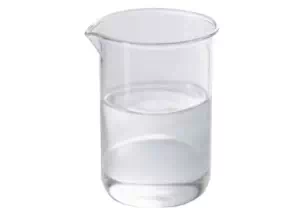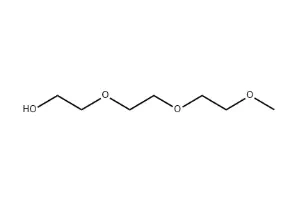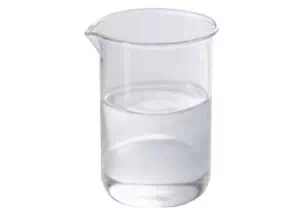All Categories



Triethylene glycol monomethyl ether CAS 112-35-6 C7H16O4
Triethylene Glycol Monomethyl Ether (TGM or MTG, chemical formula: CH₃O(CH₂CH₂O)₃H) is a colorless, transparent liquid at room temperature and pressure. It is an important multifunctional solvent and chemical additive with both hydrophilicity and moderate hydrophobicity, and is widely used in coatings, cleaning agents, electronics, medicine and other fields.
CAS : 112-35-6
Formula : C7H16O4
Mol. wt. : 164.2
EINECS : 203-962-1
| CAS | 112-35-6 |
| Molecular formula | C7H16O4 |
| Molecular weight | 164.2 |
| EIENCS | 203-962-1 |
| Form | Liquid |
| Melting point | -45°C |
| boling point | 122 °C10 mm Hg |
| Density | 1.026 g/mL at 25 °C |
| Solubility | Completely miscible in water |
| PKA | 14.36±0.10 |
| Color | Colourless |
| Storage temp | Store below +30°C. |
Basic structure:
The molecule contains a methyl ether end group (-OCH₃) and three ethoxy units (-CH₂CH₂O-), and the terminal is a hydroxyl group (-OH).
Molecular weight: 164.2 g/mol, boiling point: 194–196℃ (normal pressure), flash point: 93℃ (closed cup).
Key chemical properties:
Amphiphilicity:
Hydrophilic groups (ether bonds, hydroxyl groups) and hydrophobic groups (methyl groups) coexist, and can dissolve polar and non-polar substances.
High boiling point and low volatility:
The boiling point is significantly higher than that of water, which reduces operational volatile losses and is suitable for high-temperature processes.
Chemical stability:
Resistant to hydrolysis and oxidation, does not react with common metal ions.
Reactivity:
Terminal hydroxyl groups can participate in esterification and etherification reactions (such as synthetic surfactants).
Low toxicity:
Compared with ethylene glycol monomethyl ether (reproductive toxicity), triethylene glycol monomethyl ether has significantly lower toxicity (LD₅₀ rat oral: 4.9 g/kg).
Physical properties:
Colorless transparent liquid, density: 1.05 g/cm³ (25℃).
Soluble in water, alcohol, ether, ketone, and can dissolve oils, resins and some polymers.
(1) Industrial solvents (carriers and reaction media)
Coatings and inks:
High boiling point solvents: dilute acrylate monomers in UV-curing coatings, adjust viscosity and delay volatilization to ensure leveling.
Cosolvents: improve pigment dispersion (such as automotive paints, inkjet inks).
Cleaning agents:
Used for precision electronic components and semiconductor cleaning (removal of photoresists and ion residues), replacing toxic glycol ethers.
(2) Chemical reaction aids
Homogeneous catalyst carriers:
As solvents in palladium/platinum catalytic coupling reactions (such as Suzuki reactions) to improve catalyst solubility and stability.
Phase transfer catalyst (PTC) adjuvants:
Enhance the mass transfer efficiency of the water-organic phase interface and are used for alkylation and esterification reactions.
(3) Functional additives for the electronics industry
Photoresist additives:
Adjust the penetration rate of the developer and improve the resolution of the graphics (semiconductor manufacturing).
Lithium battery electrolyte additives:
Improve the thermal stability of the electrolyte (LiPF₆/carbonate) and inhibit electrode side reactions.
(4) Pharmaceutical and agrochemical synthesis
Drug crystallization solvent:
Control the crystal size and crystal form of API (active pharmaceutical ingredient) (such as antibiotic synthesis).
Pesticide emulsifier component:
Forms a stable emulsion with water to improve leaf adhesion (such as herbicide formulation).
Health hazards: Inhalation, ingestion or skin absorption may cause poisoning. Irritating to the skin. Decomposes with heat to release irritating smoke.
Environmental hazards: Harmful to the environment and may pollute water bodies.
Explosion hazard: This product is flammable and irritating.
Storage precautions: Store in a cool, ventilated warehouse. Keep away from fire and heat sources. Avoid direct sunlight. Keep the container sealed. It should be stored separately from oxidants and should not be mixed. It is not suitable for long-term storage. Equipped with appropriate types and quantities of fire-fighting equipment. The storage area should be equipped with leakage emergency treatment equipment and appropriate containment materials.
* Prompt reply and 24 hours online, professional team to provide best price and high quality product.
* Sample testing support.
* Every batch of products will be tested to ensureits quality.
*The packing also can be according the customers` requirment.
*Any inquiries will be replied within 24 hours.
*we provide Commerical Invoice, Packing List, Bill of loading, COA , Health certificate and Origin certificate. If your markets have any special requirements, let us know.